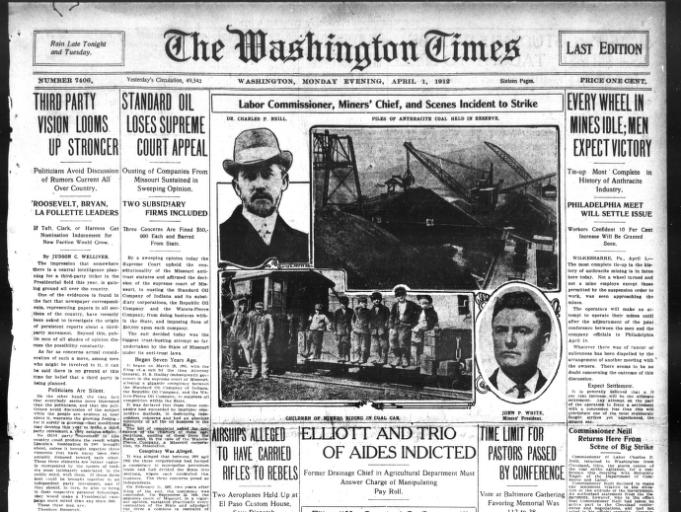|
Moderated by NW Okie! |
Volume 14 , Issue 142012Weekly eZine: (371 subscribers)Subscribe | Unsubscribe Using Desktop... |
April 1st, 1912 - Third Party Vision Looms Up Stronger

If you go back in time to 1 April 1912, Monday, The Washington Times was reporting that a possible third party vision was looming on the sidelines and getting stronger. And . . . Standard Oil was loosing it's Supreme Court Appeal.
Let us look at the news article that Judson C. Welliver wrote concerning the 3rd party vision that politicians avoided discussing as the rumors were spreading all over the country. Thoughts were that if Taft, Clark or Harmon get nomination inducement, a new faction would grow.
One of the evidences was found in the fact that newspaper correspondents, representing papers in all sections of the country, had recently been asked to investigate the origin of persistent reports about a third party movement. It was reported that among men who might be involved in it, said there was no ground at that time for such a belief of a planned third party.
Politicians were silent. It was also reported that the fact that everybody seemed more interested than the politicians, and that the politicians avoid discussion of the subject while the people were anxious to hear about it, which warranted the growing feeling that conditions may develop in 1912 to make a third party movement a serious affair.
Welliver also reported, "No third party movement in this country could produce the result which Lincoln's nomination in 1860 brought about, unless it brought together three elements that have never been very amiably disposed toward each other. The three elements are rather vaguely represented by the names of leaders most intimately associated, in the public mind, with them. If these three men could be brought together in an independent party movement, and if they should, in turn, be able to bring in their respective personal followings, they would make a Presidential campaign more mixed than any since 1860."
These three men were Theodore Roosevelt, William J. Bryan and Robert M. LaFollette. If you went anywhere among the politicians, you would hear that if these three men could bet on the same platform of popularizing the government, could co-operate in a national convention of a new party, would bury minor differences and fight on the common ground of bringing the government back to the people.
It was no secret that a large element of people in the Republican party, including those holding very high political positions as members of the party, had long discussed the question of whether the party had much longer to exist as a compromise between hopelessly opposed progressive and reactionary elements.
Bryan, Roosevelt and LaFollette had all been reliable party men. Bryan was once a populist for a short time, but since his arrival among first-class figures in national affairs he had always kept his regularity on straight, albeit the substance was not very notable at times. Roosevelt in 1884, was a very young man already a leader in his party, supported Blaine after it was generally conceded that he would bolt. LaFollette in 1904, though his Wisconsin delegation was thrown out of the national convention, remained regular. In 1908, though, he was invited to get out, but he stayed in the party.
Bryan and LaFollette were sincere and close personal friends, but between Bryan and Roosevelt, or LaFollette and Roosevelt, there had never been any lavish affection. Neither pair had been drawn together. It would be only a most extraordinary set of circumstances that would bring these three men to call upon their respective followings in a fight to create a new party.
It was thought that if Clark or Harmon could get the Democratic nomination, and if Taft could get the Republican, then the inducement for a third party would be vastly increased. The progressives in both parties, beaten at home, would see no chance at all unless they should get together in a new party for all progressives. That was the condition most likely to make a third party a serious possibility.
| View or Add Comments (0 Comments)
| Receive
updates ( subscribers) |
Unsubscribe
| © . Linda Mcgill Wagner - began © 1999 Contact Me | |
